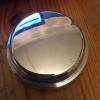Electrical Fault Found Now Have Fuse Question
#16

Posted 24 January 2013 - 08:18 PM
#17

Posted 24 January 2013 - 10:51 PM
Well, fusing the headlights is going to use four of your ten fuses, because the dip switch is single pole so you can only fuse downstream of it. You can get it down to two, if you use an excessive number of relays. How you allocate the fuses is a very big question, with no "right" answer, just some that are ok, and some that are not. FRor example, diagram 18 in Haynes shows a layout which uses 8 fuses, if you start with that, get rid of the radio, split the side/tail into left and right, and add fuses for fogs and spots, you will have used all 10.
Guess it's get out a pencil and a big sheet of paper time.
Cheers,
Bob
#18

Posted 30 January 2013 - 10:26 AM
Most modern cars use a hierarchial electrical system, lights are on different fuses, but a close look at the Mini wiring diagram will that they are not fused as standard.
You could create a seperate lighting system so that if all else blows you still have lighting, pay very close attention to ground points, if if you are using any systems that run higher than 12v such as coils and HID lighting then segregate the ground points.
this may save your life so be careful and do the job right.
99.999% of commercially available wiring harnesses do not use solder for very good reasons. however they also have the use of the correct crimping tooling for the terminals used.
Do not use those red, blue & yellow butt splices or terminations as they don't last and are less reliable, scotch locks should be banned, these are the IDC (insulation displacement connector) types that can be used to join a wire to another wire, they only work on BT installations where there is little or no vibration which is unlike your average Mini
#19

Posted 30 January 2013 - 11:24 AM
 fuse.JPG 38.78K
7 downloads
fuse.JPG 38.78K
7 downloadsThere seems to be an instant blow and a continous blow rating here. Whats the difference, a few seconds or longer?
Edited by maccers, 30 January 2013 - 11:25 AM.
#20

Posted 30 January 2013 - 11:44 AM
#21

Posted 30 January 2013 - 11:58 AM
Lucas fuses have three ratings; the continuous current they are designed to carry, the instantaneous current at which they will fuse, and the continuous current at which they will also fuse. The figure found on Lucas fuses is the continuous fusing current which is twice the continuous ampere rating that the system should be using; this can be a source of confusion when replacing Lucas fuses with non Lucas fuses.
Here is the link:
http://en.wikipedia....ive)#Lucas_type
I know some things on Wiki are not always spot on.
#22

Posted 30 January 2013 - 04:36 PM
#23

Posted 30 January 2013 - 05:03 PM
#24

Posted 30 January 2013 - 07:50 PM
#25

Posted 30 January 2013 - 09:32 PM
#26

Posted 31 January 2013 - 12:04 AM
0 user(s) are reading this topic
0 members, 0 guests, 0 anonymous users

















